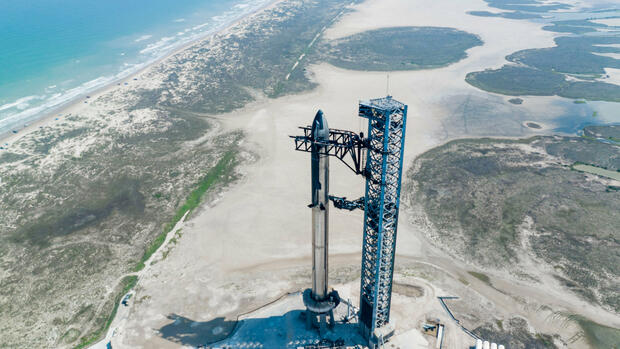Dusseldorf The flight maneuver was quite simple: two minutes after launch, the booster with 33 engines was supposed to separate from the rocket. The actual Starship rocket was supposed to orbit the earth once and land near Hawaii in the Pacific.
But the Starship’s maiden flight was aborted minutes before takeoff due to technical difficulties. There could be a new attempt in two days at the earliest.
On the one hand, SpaceX could receive orders from the American space agency Nasa. On the other hand, Starship enables the important project Starlink, with which Musk wants to make satellite internet available globally.
All in all, space travel is a dangerous undertaking, as history shows: Apollo 13 exploded in 1970 due to a faulty oxygen tank, the space shuttle Challenger in 1986 due to faulty sealing rings.
A foam seal fell on the wing of the space shuttle Columbia, crashing it in 2003. Numerous SpaceX rockets have also exploded in recent years, including four Starship prototypes from 2019 to 2021.
The reasons for the explosions are very different, but show one thing: Rockets are highly complicated machines, even the smallest misfire can have catastrophic effects. New rocket architectures in particular are prone to errors.
Why SpaceX is so cautious about Starship
In advance of the launch, Musk estimated the chances of success at about 50 percent. “I don’t want to promise that it will make it into space,” Musk said at a conference a few weeks ago.
Starship is a completely new concept and the most powerful rocket ever. The steel rocket is 120 meters high and weighs 330 tons. A total of 39 motors accelerate the rocket at launch with 62,000 kilonewtons – about twice as much as the Saturn V rocket that made the first flight to the moon.
>> Read also: Race into space – Three German rocket companies want to dare this year for the first launches
The large number of so-called Raptor engines is the greatest challenge for the engineers. 33 motors alone drive the “Super Heavy” booster, the lower stage and the booster of the rocket. Only one engine has to fail to make the rocket explode.
The Soviet Union took a similar approach with the first lunar flights with the N1 rocket, which was equipped with 30 engines. But the N1 failed four times and was discontinued in 1966. The approach of the Saturn V, which worked with five huge engines, prevailed.
Why Starship is so important to SpaceX
A successful launch of the Starship rocket would now help convince investors. SpaceX needs a lot of money to develop and build the machines – not an easy task in times of rising interest rates and inflation. The privately held company is currently looking to raise $750 million in capital, according to US financial broadcaster CNBC – at an impressive valuation of $137 billion.
Starship is a crucial project for SpaceX. The subsidiary Starlink is building a global Internet with satellites near the earth and already has around one million customers worldwide. According to Morgan Stanley, the number should rise to 364 million by 2040, so Starlink should then generate annual sales of around 80 billion dollars.
However, the company has to keep costs down, the expenses for launching and maintaining a satellite network are high. To save money, Starlink wants to put more powerful and heavier satellites into orbit. However, the previous SpaceX rocket Falcon cannot transport the satellites, which weigh up to 1.1 tons, in large numbers.
>> Read also: High-speed internet on planes – Musk is significantly expanding Starlink
A total of 7,500 of the so-called Starlink V2 satellites can be put into orbit, as a few weeks ago a permit from the US communications authority FCC revealed. Overall, Starlink wants to place more than 30,000 more satellites.
How Starship is changing space travel
The Starship rocket can carry up to 150 tons. And at an amazingly low price, Musk speaks of ten million dollars per rocket launch. Experts estimate the cost of launching the SLS rocket from Boeing or Northrop Grumman at four billion dollars.
This should be made possible, among other things, by the rocket design. Unlike other missiles, Starship is said to be reusable. The rocket is also to be built in series: one Starship per week. This reduces costs, and the company can achieve lower supplier prices, for example.
Overall, Musk wants to build 1,000 Starships to set up a Mars station. That is why the Raptor engines are also operated with methane and not with hydrogen as was previously the case. Methane has been detected in the atmosphere on Mars, so the rockets could possibly be refueled there for the return flight to Earth.
The low cost point enables new projects and revenue channels for SpaceX. For example, to build the research station planned by the space agency Nasa on the moon. According to the industry journal “Everyday Astronaut”, it costs only 2,000 dollars to bring one kilogram to the moon with SpaceX – ten times less than with the competing rocket SLS.
>> Read also: ChatGPT, Gene Therapy and Starlink – These are the five most important technology trends in 2023
SLS stands for “Space Launch System” and is built on behalf of the space agency Nasa by Boeing or Northrop Grumman. The rocket is to fly to the moon in a few years as part of the Artemis program. However, SLS is a very expensive rocket that has faced many delays.
With the successful launch of the Starship, Musk would be closer to larger orders from NASA. So far, with SLS, it has relied on trusted partners, but that could change. SpaceX has already received $1.15 billion from the US agency to set up an “Option B” for a moon flight by 2027.
More: With this spaceship technology, Germans could fly to the moon
